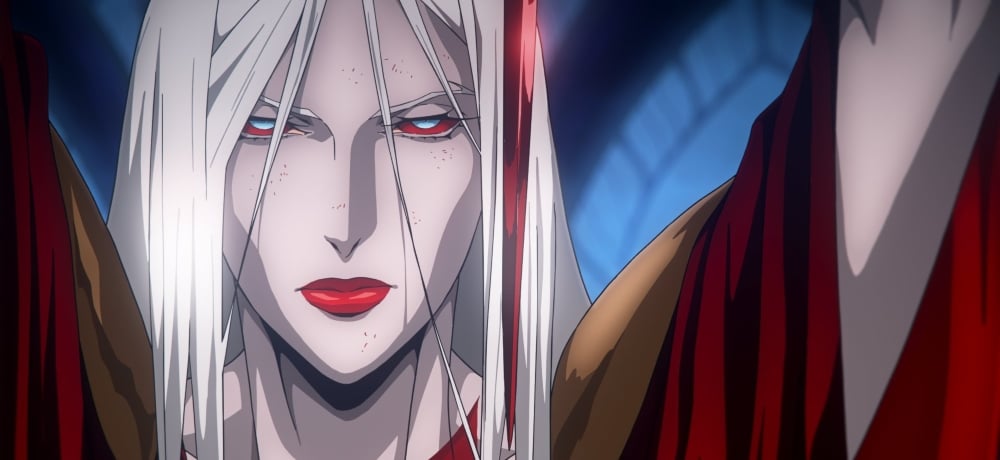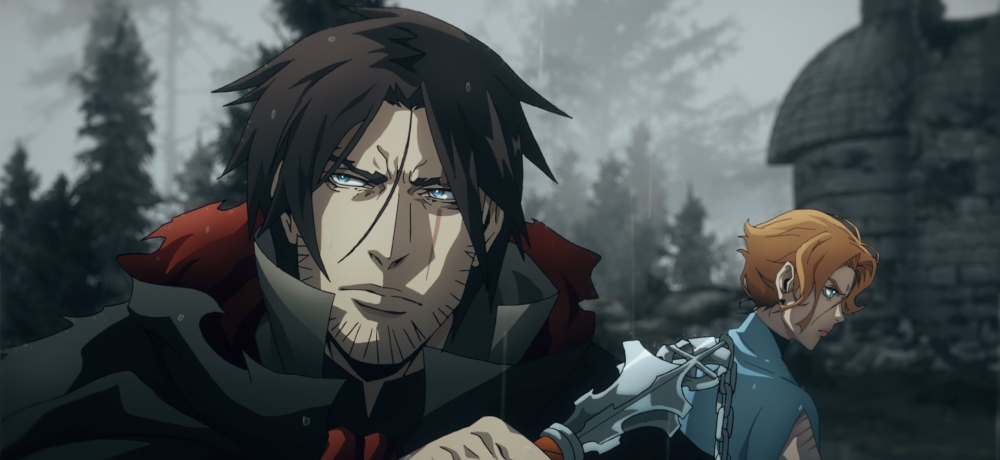


For four seasons, Netflix’s Castlevania has delivered a diamond standard of American animation in this criminally underrated series. More than just a powerhouse of Western anime styling, Castlevania has devoted itself to bloody, brilliant horror and competently tackling a piece of beloved source material. The entire series has been one hell of a ride and Castlevania’s fourth season brings the story to a close on a perfect note.
Castlevania is the creation of Warren Ellis and based on the iconic Japanese video game series. The series is directed by Sam Deats, Adam Deats, and Spencer Wan, and brought to life by the hometown favorite of this critic, Powerhouse Animation Studios. Castlevania features the voice talents of Richard Armitage, James Callis, Graham McTavish, and Alejandra Reynoso, with exciting appearances by the likes of Billy Nighy and Malcolm McDowell in the later seasons.
Season 3 left us on the edge of a hostile takeover by the vampire Carmilla and her forces, with our heroes scattered, and a mysterious portal threatening the return of Dracula. Season 4 brings viewers right back into the action, with each character facing down their fates… and prepared to battle any obstacle in their way.
Carmilla and her vampire sisters have a plan for world domination, but the factions are splintering. Trevor and Sypha are two against the world, as a cult of Dracula devotees has risen and are hell-bent on bringing the infamous mass murderer back to life. Alucard’s journey of isolation and betrayal has revealed a path to possible redemption and acceptance. As the personal stakes of each character ramp up it’s equally true that, eventually, these forces will re-enter each other’s orbits for an ultimate confrontation. With so many exciting character threads and arcs intertwining, Castlevania faces a daunting task in finding an ending to this story that truly feels like a resolution. I can happily report that the show manages to stick the landing.
Castlevania has always rested on a foundation of the power of its characters and their relationships. The entire series is about the journeys and transformations that each character undergoes and how those choices either lead to destruction or perseverance. The drama of the show has hinged on power and its corrupting nature, as the forces of good and evil vie to fill the space of power that Dracula left behind. It’s easily the most fascinating facet of the entire show.
Seasons 1 and 2 established who these characters are and placed them on the metaphorical chessboard. Trevor Belmont was the disgraced end of a proud dynasty, an unpolished loner. Sypha was also a solo magician, that went from blending in to blossoming into a full-fledged force. Forgemasters Isaac and Hector went from devoted servitude to the brave new world of possibility, choice, and power. Finally, Alucard grappled with his own relationship with his perceived monstrous self and what position he occupied in the world, thanks to the influence of his father.
While each season was defined by an ultimate confrontation and battle, the entire show is linked by themes of forgiveness and finding the path ahead. Trevor, Sypha, and Alucard found, through their friendship and support of one another, acceptance in the world, as well as love and the strength to overcome inner and outer demons. For Hector and Isaac, Castlevania is a story of freedom. Though their paths diverge in dramatic ways, both characters find a future and purpose that allows them to live for themselves and not bound to the wicked ends of others.
Even among the show’s villains, vulnerability and finding peace become focuses that allow for exciting nuance. Remember, the story of Dracula’s rage and fury is also the story of love, devotion, and grieving the loss of a great love. As for the villainous vampire sisters, each uses a reach for power to attempt to soothe an existing wound. The cunning Lenore is a diplomat in a world at war who is clinging to purpose and connection, when faced with eternal life. Striga and Morana find themselves at odds with their identities as the military and strategic arms of Carmilla’s ambitious Council of Sisters, and as a couple wishing to live happily together away from the stress of battle. Even Carmilla, who is perhaps the most one-dimensional villain of the show, is driven by vengeance and seeks power to right past wrongs committed by the powers that be.

Castlevania works because it has never shied away from the notion of expanding. The world of Castlevania grows vaster, more complex, and more beautiful with each season. The show permits itself to indulge in a lore that could span thousands of episodes, while instead choosing to allow the viewer to become lost in the expansiveness of it. It’s damn good writing. These characters are fully formed, complex, and represent histories and depth that are a delightful puzzle to the viewer. Castlevania is comfortable with its mysteries and the questions viewers may have, and that makes it all the more human and intriguing to its fans.
Powerhouse Animation Studios—which is also responsible for Netflix’s Blood of Zeus and the upcoming Masters of the Universe series (two things you absolutely should add to your watch list)—brings to bear its immense skill and talent in crafting one of the most beautiful animated shows out there. Castlevania is the perfect intersection of grisly gore, gorgeous Gothic influence, and marvelous monster design—horror fans of any persuasion will find something to love about its aesthetic. Truly, Powerhouse earns its name. Damn fine work.
If Castlevania has any flaws, it is that the show is a relentless tease and that I desperately want more. As mentioned previously, the world of Castlevania and its characters is so vast that seasons upon seasons could be spent exploring it. Stepping out of wishful thinking and back into critique, I do wish that Castlevania had permitted itself another season or two to truly roll out this narrative in the epic fashion it deserves. The entire series follows a sensible chapter model. Season 1 unleashes Dracula’s reign of terror and introduces our heroes, gradually bringing them together. In Season 2, our heroes face off against Dracula. In Season 3, our heroes are scattered and have adventures of their own as the new baddie—the Council of Sisters—is introduced. Season 4 neatly reunites the forces of good to triumph against the forces of evil, but these characters have so much going on in Season 3 that Season 4 just… doesn’t have the time. Honestly, if all the narrative covered in Season 4 had been split into a fourth and fifth season, with all those delicious details and build-up included, we’d be looking at a perfect piece of television.
That being said, it’s also true that I can’t imagine a better ending for the show than what was presented at the end of Season 4. In a show that illustrates hopelessness and horror so effectively, it’s so satisfying to end on the note of possibility. The immediate dangers have been eliminated and everyone is getting a chance to start over. The world is open, the possibilities are endless, and the future is bright for these characters that have overcome so much. It’s the ending these heroes deserve.
Castlevania is one of the most gorgeous animated works out there and its beauty goes deeper, with its richness and depth. An epic horror fantasy that can be devoured over and over again. Powerhouse Animation Studios and Netflix have knocked it out of the park with this one and I can’t wait to see what comes next.
The final season of Castlevania is available now on Netflix.
Score: 5/5
[Image Credit: Above images from Netflix Geeked.]